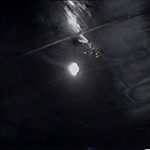 JOSEPH BEUYS
JOSEPH BEUYS
1921–1986 GERMANY
SCHMERZRAUM/PAIN SPACE, 1984
Video by Peter Kolb 40:00 min
Courtesy Peter Kolb, Neue Nationalgalerie im Hamburger Bahnhof, Berlin;
Joseph Beuys estate, VG BildKunst, Bonn
In 1984, Joseph Beuys produced a silkscreen edition with the inscription ‘Hinter dem Knochen wird gezählt – Schmerzraum’ (‘Behind the bone a count – Pain Space’). It adopted the title of an installation he had presented a year earlier at Galerie Fischer in Düsseldorf. There the artist lined the entire small gallery room with plates of lead. A naked light bulb hung from the ceiling, giving off a weak light. Beuys mounted two silver rings on the walls, their circumferences corresponding to the average size of a child’s head and an adult’s head. In keeping with the Beuysian material iconography, the lead plates represented the element of isolation since lead absorbs gamma and x-rays; it is extremely heavy and soft and at the same time highly toxic. In the science of alchemy, to which Beuys referred again and again, it plays a role as the initial basis for the synthesis of gold. Gold, for its part, bore important meaning in Beuys’s oeuvre as a symbol of purity, wisdom and strength. In the ‘Pain Space’, lead thus functioned in a sense as ‘anti-gold’. The artist countered the lead, as an isolating metal, with silver, a good conductor of heat which accordingly represented the installation’s ‘heat and energy pole’. The two different-sized rings can be understood as allusions to the age of human life. – For Beuys, the contemplation of death was one of the chief desiderata in what he considered to be an ossified society. The Munich installation ‘Show Your Wound’ of 1974/75 had already alluded to that theme; in ‘Pain Space’ and the related edition, Beuys carried the thought to completion: death is the point of view from which the value of life must be assessed: ‘Behind the bone a count.’
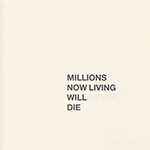 SIMON DYBBROE MØLLER
SIMON DYBBROE MØLLER
1976 DENMARK
MILLIONS NOW LIVING WILL DIE, 2004
Offset print, 24 x 20.9 cm
Edition of 175
Courtesy the artist and Galerie Kamm, Berlin
Simon Dybbroe Møller’s untitled offset print of 2004 shows nothing but a sentence: ‘Millions Now Living Will Die.’ Between the word ‘Will’ and the word ‘Die’ is a space, and on closer inspection the word ‘Never’, which is printed on the back of the paper, can just barely be discerned in it. In an effortless and cunning manner, Møller thus counters the banality of the statement that all of the millions presently living will have to die: No, never will anyone have to die. The skandalon and sheer inconceivability of death is parried with the defiant claim that it is possible to put one over on death. The statement about the death of millions is recited, as it were, in the chest tone of the majority opinion holder, the ‘never’ whispered slyly to one side by a prankster with his fingers crossed behind his back.
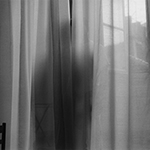 FELIX GONZALEZ-TORRES
FELIX GONZALEZ-TORRES
1957–1996 USA – CUBA
UNTITLED, 1992
Photograph, billboard
Dimensions variable
Courtesy Sammlung Goetz, Munich
Felix Gonzalez-Torres’s ‘Untitled’ is among the photographic works by the Cuban-
American artist intended for presentation both in interiors as large-scale printouts and in the public realm on advertising surfaces. It shows a view of a curtained window from the vantage point of a living room; behind the fine white fabric, the silhouette of a human being can be discerned. Gonzalez-Torres’s oeuvre bears the stamp of his confrontation with AIDS. In the nineties, the epidemic was still considered a problem exclusively affecting homosexuals. In this context, Gonzalez-Torres addressed the experience of loss and mourning and the fear of death as a general human experience, but without diverting attention from the fact that it was the homosexuals who, in particularly blatant manner, were at the mercy of a death caused by an incurable disease precisely because of the fact that both society and they themselves had closed their eyes to the danger. The presentation of his works in the public space was a simple way of reversing the principle of advertising, which is to suggest to one and all the equation of a good life with material wealth. For the artist’s images revolved around two facts that had been banished from the public consciousness: AIDS and death. It is on account of the subtlety, conceptual clarity, and semantic density with which they operate that Gonzalez-Torres’s works are among the most striking examples of contemporary reminders of death and the preciousness of life.
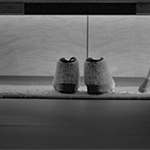 ANNA HEPP
ANNA HEPP
1977 GERMANY
A DAY AND AN ETERNITY, 2009
Video, 25 min
Courtesy the artist
Anna Hepp filmed her ninety-three-year-old grandmother going about her daily routine – preparing meals, doing her morning exercises, listening to music, checking the mailbox, getting ready for bed. The black-and-white film ‘A Day and an Eternity’ of 2009 works with long, calm shots. Between them, the grandmother is heard telling about her life and her memories. It is a portrait of an old woman from a perspective of familiarity and intimacy, yet never without due distance and respect. Dorothea Hepp died a few days after the film was finished. Shortly beforehand, she observed: ‘Age should not be excluded, because in the natural course of life every one of us will ultimately be subject to it. And we never stop having to learn and to exert ourselves; I have to keep learning every day.’
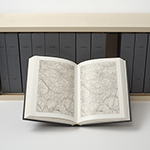 ON KAWARA
ON KAWARA
1933 JAPAN
ONE MILLION YEARS, 2009
32 audio-CDs in plywood box
Duration approx. 32 hours (loop)
Dim. over all 13,7 x 35,0 x 14,9 cm. Edition 40/250
Courtesy the MMK – Museum für Moderne Kunst, Frankfurt am Main,
Inv. Nr 2002/125
Following his Post-Surrealist early phase, On Kawara devoted himself exclusively to a single theme: the perception of time in its ambiguity as instant and perpetuity. His most well-known works are the ‘Date Paintings’; his conceptual works – such as the ones on display here – are presented less frequently. They consist of notations of everyday matters and concentration on the respective point in time, bound in book form: records of whom he met and when, where he went and when, when he got up. Postcards showing typical scenes of the respective city from which the artist sent them had the remark: ‘I got up at ….’ stamped on the back. Kawara proceeded in similar manner with the records of his daily movements, which he entered on maps. ‘One Million Years’ represents the inconceivability of time in its immeasurable continuance. In one book, he counted one million years into the past, in another one million years into the future. If a lesson can be learned from On Kawara’s works, it is undoubtedly that the ability to conceive of time abstractly neither suffices nor is it adequate for human experience. The immensity of the eternity that surrounds the short span of our lifetime and corresponds to the enormity of the number of dead who came before us and will come after us defies comprehension. In our mortality, all that remains to us as an adequate answer to the enigma of eternity is to devote our attention to the respective moment.
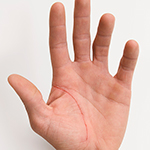 MARCEL MIETH
MARCEL MIETH
1976 GERMANY
CORRECTED LIFE LINE, 2010
Photograph, 30 x 20 cm
Courtesy the artist
Marcel Mieth’s untitled photograph shows the palm of the artist’s hand. He extended one of the lines in his hand, which in chiromancy is considered as the ‘life line’ – indicating how long one’s life will last – with the cut of a knife. The work can be read as a metaphor for an almost violent desire to make any possible effort to extend one’s own life span – may it even be by the act of self-violation. It is a kind of magical or superstitious belief at work here, a (self-) aggressive revolt against the idea that there should be no remedy against the power of death.
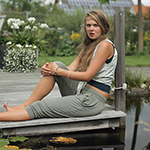 JULIA CHARLOTTE RICHTER
JULIA CHARLOTTE RICHTER
1982 GERMANY
YOU HEAR SOMETHING, 2011
Video, 07:45 min
Courtesy the artist
Julia C. Richter works with staged situations that purport to be documentary. In ‘you hear something’, we see a young woman sitting on a footbridge in a garden full of ponds and little pools and talking about her experience with dead people. She recounts the gradual changes of the skin and the noises caused by the lungs even though the person is dead. The report is interrupted by sequences in which the protagonist waters flowers or simply bathes her feet in the water. Here Richter makes use of the combination of death and a young woman, transience and beauty – known, for example, from medieval depictions of the dance of death – to create an enigmatic image of a certain way of contemplating death. The work is distinguished by a strange lack of tension; the actress’s calm manner of talking about death, the lack of a summary or conclusion, the contradiction between the young woman and her obvious but inexplicable familiarity with the subject of her report – all serve to situate the theme of this work, death, in a grey area that defies definition.
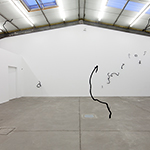 PETER RÖSEL
PETER RÖSEL
1966 GERMANY
UNTITLED, 2013
Mixed media, flock fiber
Courtesy the artist and Loock, Berlin
Peter Rösel’s untitled sculptures of 2013 are the product of a multi-stage process. Dust and lint are collected, scanned, and subsequently translated into enlarged, three-dimensional form. The black shapes mounted on the walls or in niches are visual memories of the remains, the dust, the dirt that surrounds us and that we either try to overlook or – when it becomes all too obvious – remove. Rösel collected the dust and fluff that served as the basis for the sculptures on view in this show from the desk of Adolf Hitler, which is now in the Federal Art Administration Bureau in Berlin. It is entirely irrelevant whether this dust accumulated on this desk in the past sixty years or was already there before 1945: as soon as we learn their models’ origins, Rösel’s works become formulations of ‘memento mori’, black and unpleasant mental images of absolute horror.
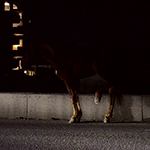 ANRI SALA
ANRI SALA
1974 ALBANIA – FRANCE
TIME AFTER TIME, 2003
Single channel video, stereo sound, 5:22 min
Courtesy the artist, Bick Productions and Hauser & Wirth
‘Time after Time’ by Anri Sala consists of a single unedited video recording made at night. It shows a horse standing at the side of a road. The sounds of traffic are heard. Now and then the picture goes out of focus and the horse’s black silhouette is engulfed in the black of the night. Every once in a while the animal bends its neck or lifts its right hind leg as if in pain. A car approaches. For a brief span of time, the horse’s emaciated body with its protruding ribs becomes visible in the grazing beam of the headlights. Then darkness returns. The oscillation between focus and fuzziness, the alternation between darkness and artificial light and the venue on the outskirts of a residential area, in a non-place at the roadside, all serve to situate the wasted animal undergoing a transition in a state of incomprehensible loneliness. Together, the prodigious indifference of the surroundings and the pitiability of this creaturely existence in the way it persists, helplessly and painfully, in its subjection to the boundary between life and death remind us of one of the most important questions underlying this exhibition: what ethics result from the contemplation of death – not only our own and the death of other human beings, but also that of all of our co-creatures on earth?
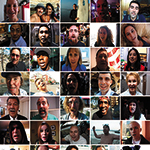 YANG ZHENZHONG
YANG ZHENZHONG
1968 CHINA
I WILL DIE, 2000-ONGOING
Video, 12 min / 13:10 min/ 7:7 min / 13:45 min
Courtesy the artist and ShanghART Gallery
Yang Zhengzhong unfolds a panorama of human beings’ ways of dealing with their own mortality. Speaking various languages, people of various origins, ethnic backgrounds, social classes and ages each say the same sentence: ‘I will die.’ Usually the camera zooms in on the face of the speaker before he or she says the sentence, and afterwards records his/her countenance for a few seconds before the picture fades out. The intonation and facial expressions vary widely, oscillating between defiance and fatalism, helplessness and fear, indifference, condescension, solemnity and ridicule. By giving expression to the wide variety of attitudes to death, the work – so it seems – also reveals the wide variety of individual attitudes towards life.
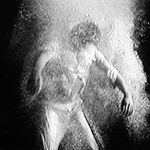 BILL VIOLA
BILL VIOLA
1951 USA
THE PASSING, 1991
In memory of Wynne Lee Viola
Videotape, black-and-white, mono sound, 54 min
Photo: Kira Perov
Bill Viola’s work ‘The Passing’ was made with the aid of a super low light camera and an infrared camera that made it possible to film at night without light. The artist moreover employed various video running speeds. He executed the work in the year in which his mother died and his second son was born. Those two events, then, are the biographical coordinates within which Viola explored notions of passage in images of which many are symbolically charged. For ‘The Passing’, he combined recordings made over a period of four years to create a video essay about becoming and passing away, birth and death. ‘For Bill Viola, – as Rolf Lauter wrote, – ‘Passages‘ signify the transition of clearly definable units of actions or being that can ostensibly be clearly defined in spatio-temporal terms into ‘concentric’ referential matrices of being that communicate with one another and exist spatially and temporarily alongside one another. Everyday events become dream images, night becomes day, memory becomes the reality of the present, different levels of time merge to become a timeless synchronicity.’ (Rolf Lauter) Or, as Viola himself wrote: ‘The Passing is a personal response to the spiritual extremes of a birth and death in the family. Black-and-white nocturnal imagery and underwater scenes depict a twilight world hovering on the borders of human perception and consciousness, where the multiple lives of the mind (memory, reality, and vision) merge.’





